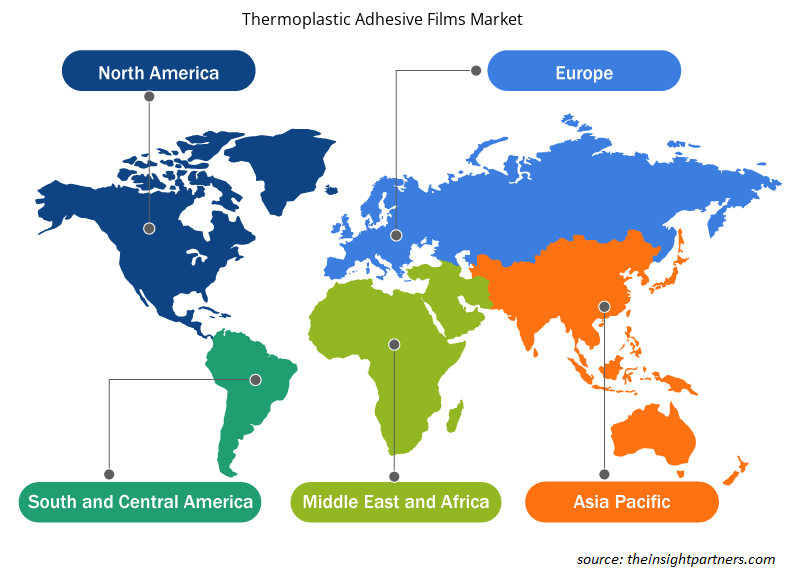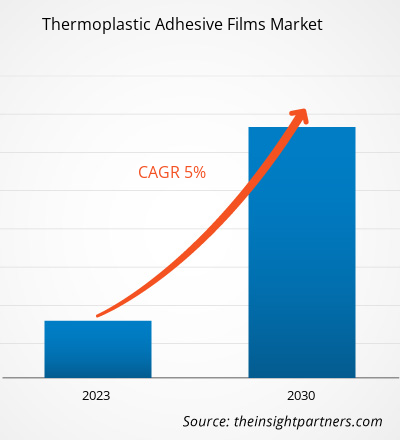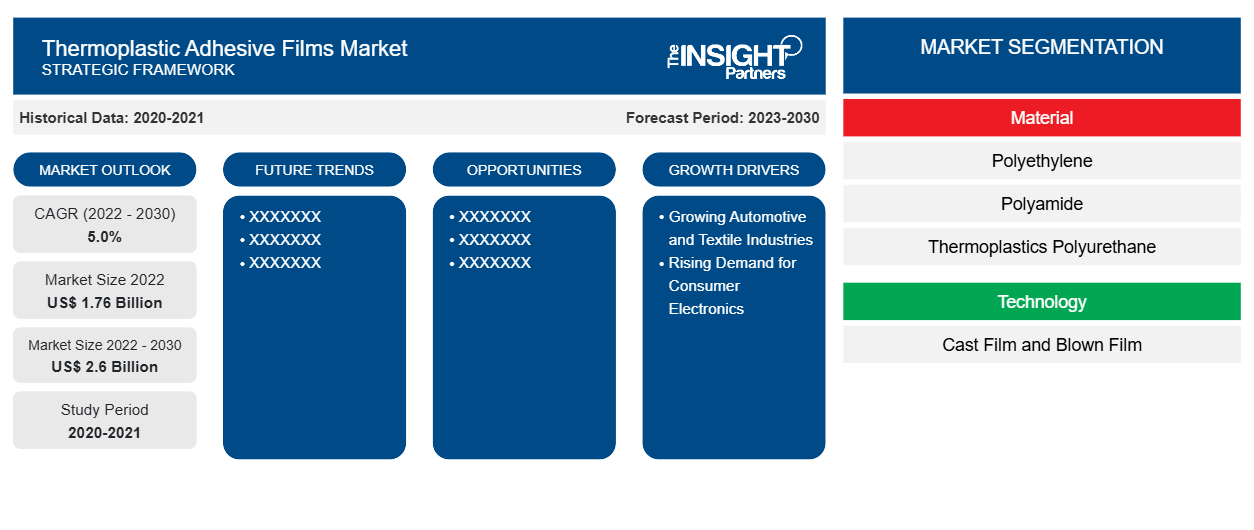[Forschungsbericht] Der Markt für thermoplastische Klebefolien hatte im Jahr 2022 einen Wert von 1.757,01 Millionen US-Dollar und soll bis 2030 2.599,37 Millionen US-Dollar erreichen; von 2022 bis 2030 wird eine durchschnittliche jährliche Wachstumsrate (CAGR) von 5,0 % erwartet.
MARKTANALYSE
Thermoplastische Klebefolien dienen mehreren Zwecken, darunter dem Verkleben elastischer Stoffe in Textilien, Schutzbarrieren in medizinischen und Automobilkomponenten und dem Verkleben inkompatibler Materialien in der Elektronik. Die Herstellung von thermoplastischen Klebefolien umfasst im Allgemeinen Produktformulierung, Extrusion, Beschichtung, Schneiden und Aufwickeln sowie Lagerung. Wichtige Marktteilnehmer stellen thermoplastische Klebefolien durch Extrusionstechnologie her, insbesondere durch Blas- und Flachfolienextrusion. Die Verwendung von thermoplastischen Klebefolien wird hauptsächlich von mehreren Endverbrauchsbranchen vorangetrieben, darunter Automobil, ballistischer Schutz, Textil, fortschrittliche Verbundwerkstoffe, Elektrik und Elektronik sowie Medizin.
WACHSTUMSTREIBER UND HERAUSFORDERUNGEN
Die wachsende Automobil- und Textilindustrie sowie die steigende Nachfrage nach Unterhaltungselektronik sind die Faktoren, die den Markt für thermoplastische Klebefolien antreiben . Die Unterhaltungselektronikbranche erlebt einen deutlichen Aufschwung aufgrund der zunehmenden Nutzung elektronischer Geräte wie Smartphones, Laptops und anderer elektronischer Produkte. Sie sind in der technologischen Welt zu einer Notwendigkeit geworden. Thermoplastische Klebefolien werden häufig in verschiedenen Unterhaltungselektronikprodukten wie Mobiltelefonen und Laptops verwendet. Die Nachfrage nach verschiedenen elektronischen Produkten steigt mit der stetigen Expansion der Unterhaltungselektronikbranche. Die zunehmende Nutzung von Smartphones, Laptops und anderen Geräten wird voraussichtlich die Anwendung von Klebesystemen zur Herstellung von Kernkomponenten vorantreiben. Die Komplexität elektronischer Geräte hat zusammen mit der Miniaturisierung elektronischer Komponenten zugenommen. Anspruchsvolle elektronische Designs erfordern eine hohe Klebefestigkeit und eine kleine Klebefläche, die thermoplastische Klebefolien bieten. Daher treibt die wachsende Elektronikindustrie auf der ganzen Welt die Nachfrage nach thermoplastischen Klebefolien an. Leichte Hybridkomponenten und fortschrittliche Verbundwerkstoffe werden in der Automobil- und Luftfahrtindustrie häufig verwendet, um Gewicht zu reduzieren und die Komponentenfunktionalität zu verbessern. Thermoplastische Klebefolien werden zur Herstellung von Hochleistungsverbundwerkstoffen und Wabenkernstrukturen verwendet. Somit treibt die globale Automobil- und Textilindustrie den Markt für thermoplastische Klebefolien an. Die Volatilität der Preise für Rohstoffe, die bei der Herstellung thermoplastischer Klebefolien verwendet werden, stellt eine Herausforderung für den Markt für thermoplastische Klebefolien dar. Störungen in der Transport- und Lieferkette, eine steigende Nachfrage nach Rohöl, eine Inflation der Rohstoffpreise und ein durch die COVID-19-Pandemie verursachtes begrenztes Angebot an Rohstoffen treiben die Preise für Erdölprodukte in die Höhe. Die steigenden Rohölpreise aufgrund schwankender globaler Wirtschaftsbedingungen treiben die Harzpreise in die Höhe. Somit bremsen Schwankungen der Rohstoffpreise das Wachstum des Marktes für thermoplastische Klebefolien.
Passen Sie diesen Bericht Ihren Anforderungen an
Sie erhalten kostenlos individuelle Anpassungen an jedem Bericht, einschließlich Teilen dieses Berichts oder einer Analyse auf Länderebene, eines Excel-Datenpakets sowie tolle Angebote und Rabatte für Start-ups und Universitäten.
-
Holen Sie sich die wichtigsten Markttrends aus diesem Bericht.Dieses KOSTENLOSE Beispiel umfasst eine Datenanalyse von Markttrends bis hin zu Schätzungen und Prognosen.
SEGMENTIERUNG UND UMFANG DES BERICHTS
Die „Globale Marktanalyse für thermoplastische Klebefolien bis 2030“ ist eine spezialisierte und eingehende Studie mit einem starken Fokus auf globale Markttrends und Wachstumschancen. Der Bericht soll einen Überblick über den globalen Markt mit detaillierter Marktsegmentierung auf der Grundlage von Material, Anwendung, Technologie, Endverbrauch und Geografie geben. Der Bericht liefert wichtige Statistiken zum weltweiten Verbrauch von thermoplastischen Klebefolien sowie deren Nachfrage in wichtigen Regionen und Ländern. Darüber hinaus bietet der Bericht eine qualitative Bewertung verschiedener Faktoren, die die Marktleistung für thermoplastische Klebefolien in wichtigen Regionen und Ländern beeinflussen. Er enthält außerdem eine umfassende Analyse der führenden Akteure auf dem Markt für thermoplastische Klebefolien und ihrer wichtigsten strategischen Entwicklungen. Eine Analyse der Marktdynamik ist ebenfalls enthalten, um die wichtigsten Antriebsfaktoren, Markttrends und lukrativen Möglichkeiten zu identifizieren, die wiederum dazu beitragen würden, die wichtigsten Einnahmequellen zu identifizieren.
Die Ökosystemanalyse und Porters Fünf-Kräfte-Analyse bieten eine 360-Grad-Ansicht des globalen Marktes für thermoplastische Klebefolien, die dabei hilft, die gesamte Lieferkette und die verschiedenen Faktoren zu verstehen, die das Marktwachstum beeinflussen.
SEGMENTANALYSE
Der globale Markt für thermoplastische Klebefolien ist nach Material, Technologie, Anwendung und Endverbrauch segmentiert. Basierend auf dem Material ist der Markt für thermoplastische Klebefolien in Polyethylen, Polyamid , thermoplastisches Polyurethan, Polyester, Polypropylen, Polyolefine, Copolyamide, Copolyester und andere unterteilt. Auf der Grundlage der Technologie ist der Markt in Gießfolie und Blasfolie unterteilt. Basierend auf der Anwendung ist der Markt für thermoplastische Klebefolien in Membranfolien, Barrierefolien und Verdunkelungsfolien segmentiert. Basierend auf der Endverwendung ist der Markt in Textil, Automobil, Elektrik und Elektronik, Medizin, ballistischer Schutz , leichte Hybridkonstruktion und andere segmentiert. Basierend auf dem Material machte das Segment thermoplastisches Polyurethan im Jahr 2022 einen erheblichen Anteil des Marktes für thermoplastische Klebefolien aus. Thermoplastisches Polyurethan wird häufig bei der Formulierung von Klebefolien verwendet, da es eine außergewöhnliche Bindungsstärke aufweist. Diese Folien können robuste und dauerhafte Bindungen auf einer Vielzahl von Substraten erzeugen, was sie für Anwendungen unverzichtbar macht, bei denen eine zuverlässige Haftung von größter Bedeutung ist. Polyester ist ein synthetisches Polymer, das normalerweise aus Erdöl gewonnen wird. Es ist ein vielseitiges Material, das für seine Stärke, Haltbarkeit und Widerstandsfähigkeit gegenüber verschiedenen Umweltfaktoren bekannt ist. Basierend auf der Technologie hatte das Segment der Gießfolien im Jahr 2022 einen erheblichen Marktanteil. Das Gießfolienextrusionsverfahren gewinnt weltweit an Popularität, da dieses Verfahren zunehmend von Herstellern thermoplastischer Klebefolien übernommen wird. Mit der Blasfolientechnologie können einschichtige und komplexe mehrschichtige Folien hergestellt werden, bei denen durch Koextrusion mehr als ein Kunststoff zu einer einzigen Folie kombiniert wird. Die Blasfolientechnologie ist für die Herstellung thermoplastischer Klebefolien sehr gut geeignet. Basierend auf der Anwendung hatte das Segment der Barrierefolien im Jahr 2022 einen erheblichen Anteil. Membranfolien aus thermoplastischen Kunststoffen eignen sich zum Verkleben von Innenteilen, da sie vollständig luftdichte Verbindungen bieten. Membranfolien haften an PE, PP und verschiedenen Dampfsperrmembranen und sind einfach zu verwenden. Die Barrierefolien aus thermoplastischem Klebstoff verhindern Kreuzkontaminationen und schützen Geräteoberflächen vor aggressiven Mitteln und Desinfektionslösungen. Diese Folie eignet sich auch für die Innen- und Außenisolierung von Wohngebäuden.
REGIONALE ANALYSE
Der Bericht bietet einen detaillierten Überblick über den globalen Markt für thermoplastische Klebefolien in Bezug auf fünf Hauptregionen – Nordamerika, Europa, Asien-Pazifik (APAC), Naher Osten und Afrika (MEA) sowie Süd- und Mittelamerika. Der asiatisch-pazifische Raum hatte einen erheblichen Anteil am Markt für thermoplastische Klebefolien und wurde im Jahr 2022 auf über 650 Millionen US-Dollar geschätzt. Der asiatisch-pazifische Raum ist die Heimat bedeutender Halbleiter- und Automobilunternehmen, darunter Samsung Electronics Co., Ltd., Sony Group Corporation, SK Hynix Inc., Toyota Motor Corporation, Tata Motors Ltd., Hyundai Motor Company, Nissan Motor Co., Ltd. und Honda Motor Co., Ltd. Diese Unternehmen konzentrieren sich auf Expansion, Forschung und Entwicklung sowie Produktinnovation. Die sich entwickelnde Automobilindustrie im asiatisch-pazifischen Raum dürfte günstige Geschäftsmöglichkeiten für Automobilkomponenten schaffen und somit den Markt für thermoplastische Klebefolien in der Region im Prognosezeitraum ankurbeln. Der europäische Markt für thermoplastische Klebefolien wird voraussichtlich im Jahr 2030 etwa 800 Millionen US-Dollar erreichen. Laut dem Bericht der Europäischen Kommission entspricht der Umsatz der europäischen Automobilindustrie 7 % des gesamten BIP der Region. Die Bedeutung der Automobil- und Textilindustrie in ganz Europa wird voraussichtlich den Markt für thermoplastische Klebefolien in der Region im Prognosezeitraum ankurbeln. Der nordamerikanische Markt für thermoplastische Klebefolien wird voraussichtlich von 2022 bis 2030 mit einer durchschnittlichen jährlichen Wachstumsrate von über 4 % wachsen. Nordamerika bietet den Akteuren im Bereich thermoplastischer Klebefolien aufgrund der wachsenden Endverbrauchsbranchen wie Automobil, Textil und Elektronik umfassende Wachstumschancen.
Branchenentwicklungen und zukünftige Chancen
Der Bericht bietet einen detaillierten Überblick über den globalen Markt für thermoplastische Klebefolien in Bezug auf fünf Hauptregionen: Nordamerika, Europa, Asien-Pazifik (APAC), Naher Osten und Afrika (MEA) sowie Süd- und Mittelamerika.
- Im August 2023 gab Kureha Corp seinen Plan bekannt, die Produktionskapazität für Polyvinylidenfluorid (PVDF) zu erhöhen.
- Im Mai 2023 weihte die Covestro AG eine Produktionslinie ein und brachte eine neue Desmopan UP TPU-Serie für Lackschutzfolien im Automobil- und Windsektor auf den Markt.
Regionale Einblicke in den Markt für thermoplastische Klebefolien
Die regionalen Trends und Faktoren, die den Markt für thermoplastische Klebefolien während des gesamten Prognosezeitraums beeinflussen, wurden von den Analysten von Insight Partners ausführlich erläutert. In diesem Abschnitt werden auch die Marktsegmente und die Geografie für thermoplastische Klebefolien in Nordamerika, Europa, im asiatisch-pazifischen Raum, im Nahen Osten und Afrika sowie in Süd- und Mittelamerika erörtert.

- Erhalten Sie regionale Daten zum Markt für thermoplastische Klebefolien
Umfang des Marktberichts über thermoplastische Klebefolien
| Berichtsattribut | Details |
|---|---|
| Marktgröße im Jahr 2022 | 1,76 Milliarden US-Dollar |
| Marktgröße bis 2030 | 2,6 Milliarden US-Dollar |
| Globale CAGR (2022 - 2030) | 5,0 % |
| Historische Daten | 2020-2021 |
| Prognosezeitraum | 2023–2030 |
| Abgedeckte Segmente |
Nach Material
|
| Abgedeckte Regionen und Länder |
Nordamerika
|
| Marktführer und wichtige Unternehmensprofile |
|
Marktteilnehmerdichte: Der Einfluss auf die Geschäftsdynamik
Der Markt für thermoplastische Klebefolien wächst rasant, angetrieben durch die steigende Nachfrage der Endverbraucher aufgrund von Faktoren wie sich entwickelnden Verbraucherpräferenzen, technologischen Fortschritten und einem größeren Bewusstsein für die Vorteile des Produkts. Mit steigender Nachfrage erweitern Unternehmen ihr Angebot, entwickeln Innovationen, um die Bedürfnisse der Verbraucher zu erfüllen, und nutzen neue Trends, was das Marktwachstum weiter ankurbelt.
Die Marktteilnehmerdichte bezieht sich auf die Verteilung von Firmen oder Unternehmen, die in einem bestimmten Markt oder einer bestimmten Branche tätig sind. Sie gibt an, wie viele Wettbewerber (Marktteilnehmer) in einem bestimmten Marktraum im Verhältnis zu seiner Größe oder seinem gesamten Marktwert präsent sind.
Die wichtigsten auf dem Markt für thermoplastische Klebefolien tätigen Unternehmen sind:
- Kureha Corp
- Protechnic SA
- Klebefolien Inc.
- Pontacol AG
- HB Fuller Co
Haftungsausschluss : Die oben aufgeführten Unternehmen sind nicht in einer bestimmten Reihenfolge aufgeführt.

- Überblick über die wichtigsten Akteure auf dem Markt für thermoplastische Klebefolien
AUSWIRKUNGEN DER COVID-19-PANDEMIE/AUSWIRKUNGEN DES GEOPOLITISCHEN SZENARIOS/AUSWIRKUNGEN DER REZESSION
Branchen wie die Automobil-, Elektronik- und Textilindustrie sind die Hauptverbraucher von thermoplastischen Klebefolien. Im Jahr 2020 mussten diese Branchen ihre Betriebsabläufe aufgrund von Störungen in der Wertschöpfungskette aufgrund staatlicher Vorschriften und Handelsbeschränkungen verlangsamen. Darüber hinaus beeinträchtigten von verschiedenen Ländern verhängte Lockdowns im selben Jahr die Lagerbestände vieler Hersteller. Der Mangel an Arbeitskräften führte zu einer Verringerung der Produktion und des Vertriebs von thermoplastischen Klebefolien. Darüber hinaus verringerten staatliche Beschränkungen und andere COVID-19-bezogene Vorsichtsmaßnahmen die Betriebskapazitäten der Beteiligten in der Wertschöpfungskette für thermoplastische Klebefolien.
Ende 2021 begann sich der globale Markt für thermoplastische Klebefolien von den Verlusten des Jahres 2020 zu erholen, mit der Wiederbelebung von Endverbrauchsbranchen wie Automobil, Textil, ballistischer Schutz sowie Elektrik und Elektronik. Der Ausbau der Produktionskapazitäten in der Chemie- und Materialindustrie nach der COVID-19-Pandemie in vielen Regionen wie dem asiatisch-pazifischen Raum und Nordamerika dürfte in den kommenden Jahren lukrative Möglichkeiten für den Markt für thermoplastische Klebefolien schaffen.
WETTBEWERBSLANDSCHAFT UND SCHLÜSSELUNTERNEHMEN
Kureha Corp, Protechnic SA, Adhesive Films Inc, Shanghai Xingxia Polymer Products Co Ltd, Pontacol AG, HB Fuller Co, Covestro AG, Scapa Group Ltd, Prochimir Inc, Fenyang Dingxin Films Technology Co Ltd und Fait Plast SpA sind einige der wichtigsten Akteure auf dem Markt für thermoplastische Klebefolien.
- Historische Analyse (2 Jahre), Basisjahr, Prognose (7 Jahre) mit CAGR
- PEST- und SWOT-Analyse
- Marktgröße Wert/Volumen – Global, Regional, Land
- Branchen- und Wettbewerbslandschaft
- Excel-Datensatz
Aktuelle Berichte
Verwandte Berichte
Erfahrungsberichte
Grund zum Kauf
- Fundierte Entscheidungsfindung
- Marktdynamik verstehen
- Wettbewerbsanalyse
- Kundeneinblicke
- Marktprognosen
- Risikominimierung
- Strategische Planung
- Investitionsbegründung
- Identifizierung neuer Märkte
- Verbesserung von Marketingstrategien
- Steigerung der Betriebseffizienz
- Anpassung an regulatorische Trends























 Kostenlose Probe anfordern für - Markt für thermoplastische Klebefolien
Kostenlose Probe anfordern für - Markt für thermoplastische Klebefolien